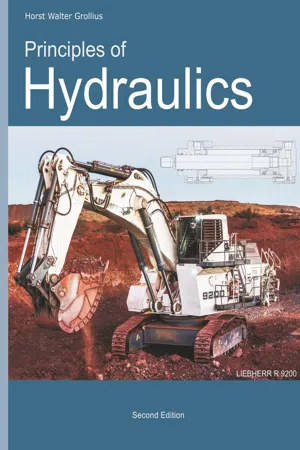![]()
1 Introduction
Fluid power is the generic term for the areas of hydraulics and pneumatics. In the area of hydraulics the fluids are liquids; in the area of pneumatics gas is used, namely air. In the beginnings of the hydraulics water was used as the fluid for energy transfer. Since the beginning of the 20th century oils are used. These have lubrication- and corrosion protection in addition. For some years water is also reused as the fluid for energy transfer in individual cases for reasons of environmental protection and costs, also called “water hydraulics”. The present book deals mainly with the physical principals relevant for oil-operated hydraulic systems (usually mineral oils are used).
The oil-hydraulic is divided into the areas of hydrodynamic and hydrostatic energy transfer.
The hydrodynamic energy transfer uses an impeller in order to transfer mechanical energy to the oil. The flow energy of the oil is used to drive a turbine wheel. These systems are called hydrodynamic drive systems (for example Föttinger converters and Fluid couplings).
In the case of the hydrostatic energy transfer, a mechanically driven pump (hydraulic pump) produces a mainly pressure-loaded volume flow which is supplied to a hydraulic cylinder or a hydraulic motor. Therein, the pressure energy is reconverted into mechanical energy. These are called hydrostatic drive systems.
The kinetic energy is negligible in systems with hydrostatic transfer energy compared to the pressure energy. Conversely, the pressure energy contained in the flow can be neglected in hydrodynamic energy systems. In mechanical engineering, the hydrostatic drive systems have a much greater importance than the hydrodynamic drive systems.
![]()
2 Physical Principles
2.1 Pressure Definition, Absolute Pressure, Overpressure, Pressure Units
For the explanation of the pressure definition a volume section from a fluid shall be considered as shown in Figure 2.1.
Figure 2.1: For the explanation of the pressure definition
The characteristic fluid point O is equal to a point located on the surface of the part fluid (Figure 2.1). At point O the surface element dA is situated, where the force dF is acting vertically. The pressure p is the quotient of dF and dA:
The pressure value is independent of the cutting sectional plane direction touching point O . That means the pressure is a scalar physical quantity; its numerical value depends only on the place in the fluid.
Below, the terms absolute pressure and overpressure (= pressure measured relative to atmospheric pressure) will be explained based on Figure 2.2.
Figure 2.2: Absolute pressure scale and overpressure scale
The absolute pressure scale (upper scale in Figure 2.2) starts at pabs = 0 (pressure at vacuum). The difference between the absolute pressure pabs and the local (absolute) atmospheric pressure pamb is the atmospheric pressure difference:
This pressure difference is called overpressure (or gauge pressure).
If the absolute pressure pabs is higher than the local (absolute) atmospheric pressure pamb the overpressure became positive value
If the absolut pressure pabs is lower than the actual (absolute) atmospheric pressure pamb the overpressure became negative value
The minimal (theoretical) overpressure value pe,min is determined by the actual (absolute) atmospheric pressure pamb. For example, if there is a pressure with pamb =1,05bar as shown in Figure 2.2 the minimal overpressure value is
The example shows: The numerical value of the minimal overpressure value is depending on the actual (absolute) atmospheric pressure value pamb.
NOTE: Often the indices “abs” and “e” are omitted for clear identification of absolute pressure and overpressure. From the context it is to find out whether absolute pressure or overpressure is of importance.
A commonly used unit of pressure based on the International SI-System is Pascal (unit symbol: Pa)
(Pa = Pascal, N = Newton, kg = kilogram, m = meter, s = second)
An also often used unit is Bar (unit symbol: bar ):
Small pressure values are given in millibar (unit symbol: mbar) or hectopascal (unit symbol: hPa)
The unit used in Anglo-Saxon countries is Psi (unit symbol: psi):
2.2 Law of Pascal
The law of Pascal is the fundamental law of hydrostatics. It is valid f...











